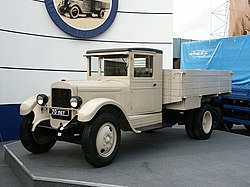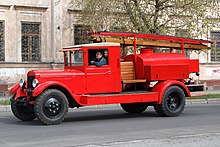ZIS-5
| ZIS | |
|---|---|
|
Restored ZIS-5 from 1933 at an exhibition in Moscow (2003)
|
|
| ZIS-5 | |
| Manufacturer: | Zavod imeni Stalina |
| Sales designation: | ЗИС-5 |
| Production period: | 1933–1948 at ZIS, until 1958 with modifications at UralZIS |
| Previous model: | AMO-3 |
| Successor: | ZIS-150 |
| Technical specifications | |
| Designs: | Flatbed, military superstructures, various conversions |
| Engines: | Six-cylinder gasoline engines |
| Power: | 54 to 62.5 kW |
| Payload: | 3 t |
| Perm. Total weight: | 6.1 t |
The truck ZIS-5 ( Russian ЗИС-5 ) is a Soviet truck that was first built in Zavod imeni Stalina from 1933 . The vehicle was one of the most widely produced trucks in the Soviet Union from the 1930s to 1950s. During the 25 years of series production, a total of almost one million pieces were produced in various factories. In 1947, at the end of production in Moscow, there was a version with a revised engine, which was designated as the ZIS-50 . A three-axle variant was also produced, the ZIS-6 . Almost identical trucks were also designated as UralZIS-5 and UralZIS-355 because they were manufactured in plants other than the ZIS headquarters in Moscow .
history
In the summer of 1933, the first prototypes of the ZIS-5 were produced in the Moscow ZIS plant as a successor to the outdated AMO-2 and AMO-3 trucks. The truck was mass-produced relatively quickly, namely from October 1, 1933. From 1934 the first models were exported to Turkey . The ZIS-5 was the first truck from its own production that the Soviet Union sold to other countries. The main buyer, however, was the Red Army . As of June 20, 1941, there were already over 100,000 pieces in their inventory.
Production in Moscow was stopped in autumn 1941 and relocated to the Urals due to the war. From February 1942 to 1944 the truck was manufactured in Uljanowski Avtomobilny Sawod , then UAZZIS. From July 8, 1944, UralZIS also manufactured the truck under the name UralZIS-5. However, the ZIS plant in Moscow resumed production in April 1942. The ZIS-5 was built here until 1948.
Production numbers
- In the Moscow ZIS plant: approx. 700,000 copies from 1933 to 1948 (with an interruption from autumn 1941 to April 1942)
- At UAZZIS in Ulyanovsk : approx. 6,500 copies
- At UralZIS : approx. 200,000 copies (until 1955)
In total, nearly 920,000 ZIS-5s were made.
In the course of the production history of 15 years, modifications were made to the ZIS-5 again and again. As a result of the war, the trucks were simplified from 1941 onwards. Due to a shortage of materials in the metal sector, many parts were made of wood, seats, driver's cabs and doors for example. The bumpers have been left out completely, the fenders have been greatly simplified, and the right headlight has been partially saved. The vehicles were designated as ZIS-5W (Russian ЗИС-5В), where the W stands for war, Russian Война. These changes were only partially reversed after the end of the war. Nevertheless, the truck was valued for its reliability and simple construction.
In 1955, the UralZIS factory, which was still producing the UralZIS-5, reversed the changes brought about by the war and material shortages. The vehicle that was delivered with round fenders and sheet steel cab was given the name UralZIS-355 and was produced until 1957. In 1958 its successor went into production, the completely revised UralZIS-355M .
Model variants


- ZIS-5 : basic version
- ZIS-6 : three-axle vehicle
- ZIS-10: ZIS-5-based tractor unit *
- ZIS-11: version with extended wheelbase, produced 1934–1941 (rarely built)
- ZIS-12: also extended wheelbase (1934–1938 (?))
- ZIS-13: Wood gasifier variant of the ZIS-11 (1936–1938) *
- ZIS-14: also a version with an extended wheelbase *
- ZIS-15 and ZIS-17: prototypes of a successor to the ZIS-5, not in series production due to the war *
- ZIS-16 : Bus based on the chassis of the ZIS-5
- ZIS-18: wood gasification variant of the ZIS-15 *
- ZIS-21 and ZIS-21A: series-produced wood gasification variants with a market share of around 9%
- ZIS-22 : Half-track vehicle (built 1938–1941) *
- ZIS-23: three-axis variant of the ZIS-15 *
- ZIS-24: Offroad version of the ZIS-15 *
- ZIS-26: Tractor based on the ZIS-15 *
- ZIS-30: Wood gasifier variant of the ZIS-5 (1941) *
- ZIS-31: wood gasifier similar to ZIS-21 *
- ZIS-32: all-wheel drive variant ZIS-5 *
- ZIS-33: Half-track vehicle based on the ZIS-5 (1940) *
- ZIS-35Sh: Half-track vehicle *
- ZIS-36: three-axle version with all-wheel drive, prototype (after 1936) *
- ZIS-41: wood gas variant of the ZIS-5 *
- ZIS-42 : Half-track vehicle, mass-produced (1942–1944)
- ZIS-44: Ambulance vehicle for use in World War II
- ZIS-50: ZIS-5 with revised engine, late 1940s
All versions marked with * were prototypes or were built very rarely. Since there were problems with the fuel supply in the north of the Soviet Union in the 1930s, wood gasifiers were a good alternative to gasoline engines.
Technical specifications
All data apply to the basic version ZIS-5.
Weights and dimensions
- Length: 6060 mm
- Width: 2235 mm
- Height: 2160 mm (height of the cabin)
- Wheelbase: 3810 mm
- Turning circle radius: 8900 mm (measured on the front fender)
- Ground clearance: 250 mm (on the rear axle)
- Front track: 1545 mm
- Rear track: 1675 mm
- Empty weight: 3000 kg
- Payload: 3100 kg
- Permissible total weight: 6100 kg
Drive data
- Engine type: ZIS-5
- Engine: Otto engine, 6 cylinders in line
- Power: 54–62.5 kW (73–85 hp, depending on the year of construction)
- Displacement: 5555 cm³
- Compression: 4.6: 1 (later also 5.3: 1 and 5.7: 1)
- Top speed: 60 km / h
- Tank capacity: 60 l, tank under the driver's seat
- Consumption: 34 l / 100 km
- Drive formula : (4 × 2)
- Transmission: 4 forward gears and one reverse gear, all unsynchronized
- Clutch: 2-disc, dry
The vehicle was leaf-sprung on the front and rear axles. Contemporary sources suggest that engine output in the 1930s was below the stated 73 hp and was closer to 67 to 68 hp. In the 1950s, the top speed was increased to 70 km / h. Extensive maintenance of the vehicle had to be carried out approximately every 1,200 km. After this distance, an oil change was mandatory. A general overhaul was carried out every 50,000 to 85,000 km, depending on the condition of the road.
The engine of the ZIS-5 was used identically as a supplier part in the significantly heavier JaG-6 truck .
Individual evidence
- ↑ Website for ZIS-5 with a note for simplification in the war years (Russian)
- ↑ Article of the Russian auto magazine 5koleso available online on various vehicles and trucks used in World War II (Russian)
- ↑ Website for UralZIS-355 (Russian)
Web links
- Comprehensive collection of technical data and production history (English)
- Summary of the technical data (English)
- List of model variants (English)



